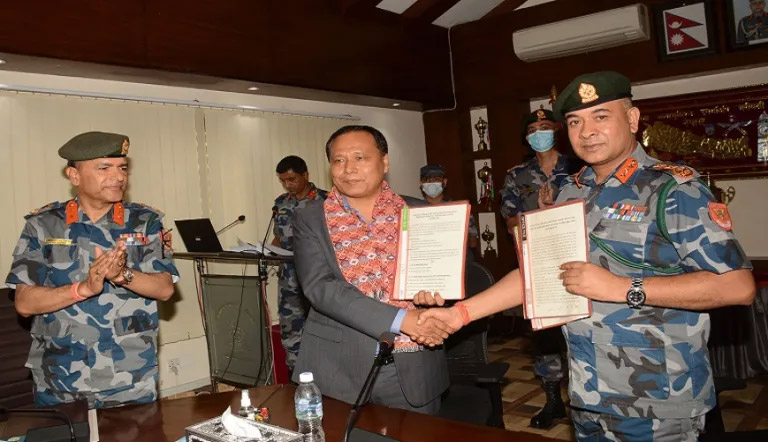
A memorandum of understanding (MoU) has been signed between the Nepal Electricity Authority (NEA) and the Armed Police Force (APF Nepal) for the use of electric stoves. Inspector General Raju Aryal on behalf of the Armed Police Force and Executive Director Kulman Ghising on behalf of the Authority signed the memorandum of understanding in a program held at the Armed Police Headquarters Halchowk.
The Nepal Electricity Authority, which has been promoting electric vehicles and stoves as an institution, has once again entered into an agreement with another organized organization.
According to the agreement, induction stoves will be gradually used to replace the use of LP gas in the kitchens (mess) operated in the armed police barracks. The authority will create the necessary physical infrastructure for the use of induction stoves, such as adding electricity poles and placing large capacity transformers.
In the event, Inspector General Aryal told the armed police personnel present throughout the country that a large amount of gas is being used while managing the mess, so it is considered a great opportunity to use an electric stove instead.
"Using domestically produced electricity through the use of induction stoves will increase domestic energy consumption on the one hand, and on the other hand, fuel imports can be reduced", he said, "This will reduce the deficit created by foreign exchange spending on fuel imports and will also have a positive impact on the national economy." Aryal mentioned that the use of electric stoves will benefit not only the organization but also the country.
Ghisingh, executive director of the authority, said that the use of electric stoves in the Mess of the Armed Police is an important step to increase electricity consumption internally.
"If we can spend the green electricity produced in the country here, we can save more than four billion rupees which is spent annually on the import of petroleum products. Let's use electric vehicles, increase the consumption of electricity by cooking on electric stoves", he said.
Using electric vehicles costs much less than running on petroleum products, and cooking using electric appliances is much cheaper than using gas, he says that infrastructure construction is being done as a campaign to make electricity supply reliability and quality.
The Armed Police Force has eight divisions, 44 Ganas, 44 Gulmas, 222 BOPs, and 14 training centers across the country. Up to three meshes are running in each office. The gas used for cooking costs about 400 million rupees annually.
A memorandum of understanding regarding the construction and operation of an electric vehicle charging station has also been signed between the Armed Police Force and the Authority. According to the agreement, charging stations will be established at 17 locations, including the two petrol pumps currently operated by the Armed Police Welfare Service Center and 15 suitable locations of the Armed Police offices.
The charging station will be operated under the welfare fund in the long term. A memorandum of understanding has already been signed between the authority and the Nepal Police to establish charging stations at 25 places.
According to the agreement, the authority will purchase all the equipment for the charging station and build the infrastructure at its own expense. The authority will also do the maintenance and regular servicing of the equipment. The armed police will provide a suitable location for the construction of the infrastructure and after construction will operate and protect the charging station. It has been arranged that charging stations cannot be allowed to be operated by third parties/organizations.
While operating the charging station, the authority should make arrangements to allow the general public to use it easily at the rate determined by the time. The authority will collect the fee paid by the consumer while charging the vehicle.
According to the provisions of the Electricity Distribution Regulations, the Welfare Center of the Armed Police will receive 50 percent of the total profit from the electricity tariff rate as the operating and management expenses of the charging station.
To encourage the use of electric vehicles, the authority is constructing state-of-the-art charging stations that can charge quickly at 51 locations across the country. Every charging station being constructed by the authority will be equipped with a 142 kW charger, a 50 kVA transformer for power supply, and an online charging system.
Fast charging 60/60 KW DC and 22 KW AC chargers will be placed at the charging station. With this, three vehicles including big buses can be charged simultaneously.
The software of the charging station will be kept in the authority's data center so that it can serve more than 300 chargers. All 50 stations will be controlled from Kathmandu. After charging the vehicle, the customer can pay the bill through the QR code and mobile app.
APF Nepal (Sashastra Prahari)




